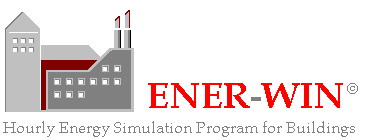
(1) General Description:
ENER-WIN is the Windows version of an hourly energy simulation model developed at Texas A&M University for estimating annual energy consumption in buildings. The program features an interactive graphical interface for input and output. The simulation model uses streamlined algorithms that permit hour-by-hour energy calculations in minimal time. It is in compiled Visual FORTRAN-95 and features: transient modeling based on sol-air temperature, time lag, decrement factor, ETD; zone loads and temperatures based on a heat balance methodology; and daylighting algorithms based on a modified Daylight Factor methodology.
Energy results are expressed in terms of both annual fuel consumption and the energy use index (EUI), which expresses annual energy use per unit floor area. The program package includes a weather database (15 to 30-year statistics) of over 10,400 cities worldwide, and features graphical and tabular output reports including: weather data statistics summary; zone data, materials and windows properties summary; monthly peak demand and energy charges; annual energy and cost breakdowns for various components; peak system and zone loads, design air supply volumes, duct sizes; life-cycle (Present Worth) cost analysis; and annual weather summary for validation purposes.
The program is supported with numerous default data bases and accommodates 30 building types, multiple profiles for occupancy, hot water, lighting, zone temperatures, and ventilation rates; up to 98 HVAC zones, 20 each of different wall and window types, and 400 wall surfaces/orientations/ shading conditions in each run.
ENER-WIN had originally been introduced through annual training seminars conducted at Texas A&M University. It was also introduced to architecture schools in North America through Vital Signs, a curriculum development project centered at the College of Environmental Design at U.C. Berkeley, and is now used in several universities in China, Thailand and Australia.
(2) Estimation of the annual energy performance of buildings:
ENER-WIN estimates the annual energy performance of buildings by reporting total annual energy consumption
and the overall energy use index (EUI), in terms of Mega Joules
per square meter or Btus per square foot per year. The program allows for
optional use of SI (Metric) or IP (British) units.
(3) Identification of targets of opportunity for energy reductions:
ENER-WIN facilitates the examination of building configurations and
thermal properties which may help to reduce annual cost and conserve energy. It
does this by providing percentage breakdowns for heating and cooling energy
expenditures for a number of building components, like walls, windows,
skylights, interior equipment, and lighting systems.
(4) Estimation of the peak design loads:
Peak loads are produced for heating and cooling for the entire building central plant as well as for each
zone of the building. Output also includes duct sizes and required air
(or water) supply quantities for heating and cooling peak loads.
(5) Calculation of space comfort conditions for passive designs:
The program calculates discomfort degree-hours for the internal occupied
environment of non air-conditioned (passively heated and cooled) buildings. In
this mode, the software permits the space to float through an unrestricted range
throughout the whole year. This feature permits a detailed study of the effects
of thermal mass, window placement, and thermal envelope properties.